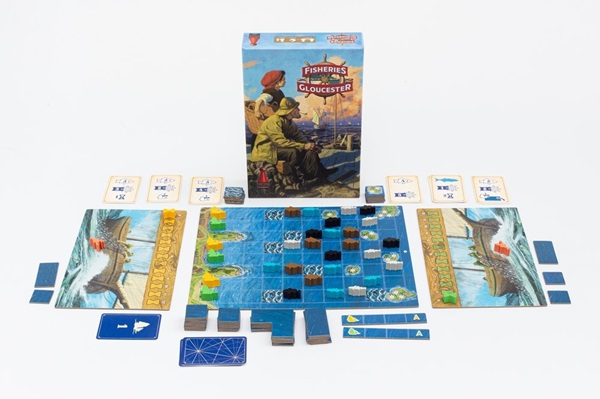Will You Catch the Best Load in Fisheries of Gloucester?

Take to the sea to haul in fish and make a living. But you’ll have to be equal parts canny and fast, as your opponent races to beat you to the best fishing spots and the wealthiest islands.
Published by Dr. Finn's Games, Fisheries of Gloucester is a 2-player game with a 45-minute play time.
Gameplay
The board shows a grid of spaces laid out in columns and rows. On certain spaces you place fish, randomizing which colors go where. There are four different colors of fish, with six fish of each color. Each player has three ships, which start on the far left of the board.
At the start of each round, you draw a chart card. This gives each player two ocean tiles, with the card dictating what shapes these tiles have. The player who goes first earns six time points (time saved from the previous round also carries over) and the second player is given seven. Players then alternate taking turns.
On your turn, you take one action. You can chart a course, sail, fish, or preserve fish. When charting a course (which does not cost any time), you play one of your ocean tiles onto the board. You must play it adjacent to a space that has a ship on it, and it cannot cover a space that shows rough water, an island, or that currently holds a fish. When you sail, you move one of your ships. It can only move on ocean tiles, rough water, or islands. You must spend one time point for each empty ocean tile space it moves onto, and two points for moving onto rough water or onto a space with another ship. You cannot stop your ship’s movement on a space that has another ship, and if you land on an island your ship must stay there for the rest of the game. Also, you can never move one of your ships so that it is more than three columns ahead of your ship that is farthest to the left on the board.
When you take the fishing action, all your ships can fish, collecting fish that are adjacent to them, but you must spend one time point for each fish that you take. Finally, you can only take the preserve fish action once per round. When you preserve fish, you must discard the correct fish in order to collect the indicated preservation cards. There are six different kinds of preservation cards: some require you to discard a specific color of fish, while others require you to collect sets either of matching or all different colors of fish. You then gain the immediate reward listed on the card you have just claimed. This might be more time points or moving your ship for free, for example. Each card is also worth a certain amount of points at the end of the game.
Each player has one lobster token in the game. You may discard your lobster to immediately take a second turn after just completing one.
Instead of taking an action on your turn, you may instead choose to end the day. This allows you to choose whether to go first or second next round. The other player gets to continue taking turns and spending his time until he has no more actions he wishes to take, and then you begin the next round.
After six rounds, the player with the most points wins the game. You earn points from your preservation cards and from any islands that your ships have landed on, which are worth 1-3 points.

Photo provided by the publisher
Review
Fisheries of Gloucester is an interesting blend of set collection and racing. You’re trying to advance your ships quickly, as you and your opponent vie for the limited space on the board and the limited resources, all while not being able to leave any one of your ships too far behind.
You only take one action on your turn, and your opponent can move on any tiles you lay down, so you always have to consider what possibilities your action will open up for your opponent. In turn, they will have to sometimes weigh the time cost of taking fish you’re after with going after other fish closer at hand.
There are also a limited number of preservation cards, which are another resource that players are racing each other for. All of these elements lead to a game where there’s plenty of player interaction without feeling like a "take-that' game.
The game also comes with a variant that allows you to change out where the rough water, islands, and fish are on the board during set-up, allowing for more variety. It might be nice if more preservation cards were included, randomized at the start of the game to keep things fresh.
Fisheries of Gloucester is a solid two-player game, where you’re constantly getting into each other’s space as you race to different locations on the board. Since the fish don’t score in and of themselves, choosing which preservation cards to pursue is important. Overall, this is a nicely-designed game that really pits the two players against each other without ever feeling mean.
Pros: Lots of player interaction, variant that allows you to alter board setup
Cons: Could use more preservation cards
Disclosure: we received a complimentary review copy of this game.







